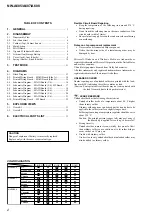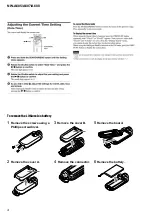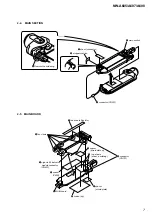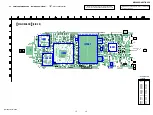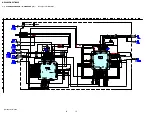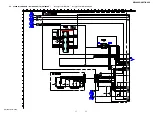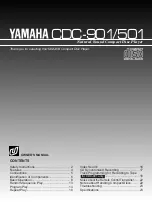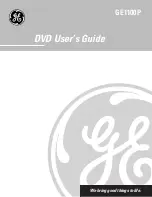
2
NW-A605/A607/A608
TABLE OF CONTENTS
1.
GENERAL
...................................................................
3
2.
DISASSEMBLY
2-1.
Disassembly Flow ...........................................................
5
2-2.
Lid (Connector) ...............................................................
6
2-3.
Cabinet (Top), Cabinet (Inner) ........................................
6
2-4.
Main Section ....................................................................
7
2-5.
MAIN Board ....................................................................
7
2-6.
Organic El Indicator Module ...........................................
8
2-7.
Lithium (Ion) Storage Battery .........................................
8
2-8.
Cover (Jack), Arm (Shuttle) ............................................
9
2-9.
Spring (Shuttle), Knob (Shuttle) ..................................... 10
3.
TEST MODE
............................................................... 11
4.
DIAGRAMS
4-1.
Block Diagram ................................................................ 13
4-2.
Printed Wiring Board – MAIN Board (Side A) – ........... 14
4-3.
Printed Wiring Board – MAIN Board (Side B) – ........... 15
4-4.
Schematic Diagram – MAIN Board (1/6) – ................... 16
4-5.
Schematic Diagram – MAIN Board (2/6), SW Board – . 17
4-6.
Schematic Diagram – MAIN Board (3/6) – ................... 18
4-7.
Schematic Diagram – MAIN Board (4/6) – ................... 19
4-8.
Schematic Diagram – MAIN Board (5/6) – ................... 20
4-9.
Schematic Diagram – MAIN Board (5/6) – ................... 21
4-10. Printed Wiring Board – SW Board – .............................. 22
5.
EXPLODED VIEWS
5-1.
Overall-1 .......................................................................... 31
5-2.
Overall-2 .......................................................................... 32
6.
ELECTRICAL PARTS LIST
.................................. 33
Microsoft, Windows and Windows Media are trademarks or
registered trademarks of Microsoft Corporation in the United States
and/or other countries.
US and foreign patents licensed from Dolby Laboratories.
All other trademarks and registered trademarks are trademarks or
registered trademarks of their respective holders.
UNLEADED SOLDER
Boards requiring use of unleaded solder are printed with the lead-
free mark (LF) indicating the solder contains no lead.
(Caution: Some printed circuit boards may not come printed with
the lead free mark due to their particular size)
: LEAD FREE MARK
Unleaded solder has the following characteristics.
•
Unleaded solder melts at a temperature about 40
°
C higher
than ordinary solder.
Ordinary soldering irons can be used but the iron tip has to be
applied to the solder joint for a slightly longer time.
Soldering irons using a temperature regulator should be set to
about 350
°
C.
Caution: The printed pattern (copper foil) may peel away if
the heated tip is applied for too long, so be careful!
•
Strong viscosity
Unleaded solder is more viscou-s (sticky, less prone to flow)
than ordinary solder so use caution not to let solder bridges
occur such as on IC pins, etc.
•
Usable with ordinary solder
It is best to use only unleaded solder but unleaded solder may
also be added to ordinary solder.
Flexible Circuit Board Repairing
•
Keep the temperature of the soldering iron around 270
°
C
during repairing.
•
Do not touch the soldering iron on the same conductor of the
circuit board (within 3 times).
•
Be careful not to apply force on the conductor when soldering
or unsoldering.
Notes on chip component replacement
•
Never reuse a disconnected chip component.
•
Notice that the minus side of a tantalum capacitor may be
damaged by heat.
COLOR VARIATION
US
NW-A605
NW-A607
SILVER
VIOLET
BLUE
PINK
GOLD
Hong Kong
Korean
Chinese
NW-A608
US
Canadian
AEP
Hong Kong
Korean
Chinese
US
Hong Kong
Korean
Chinese
CAUTION
Danger of explosion if battery is incorrectly replaced.
Replace only with the same or equivalent type.


